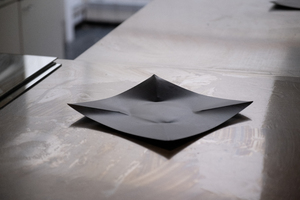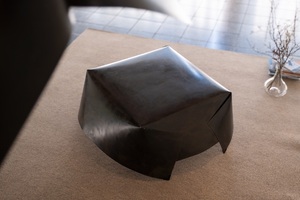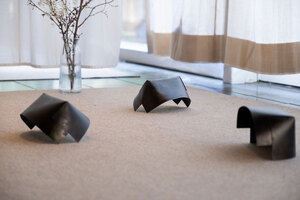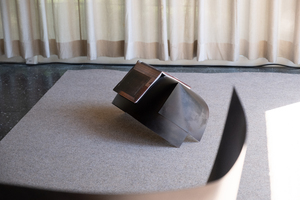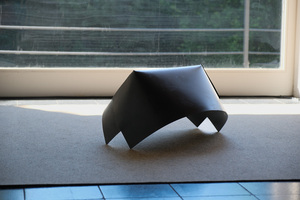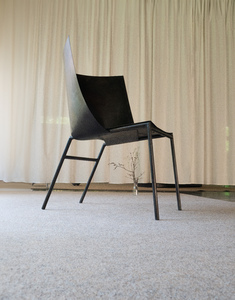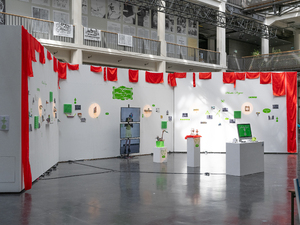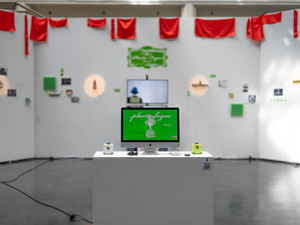"Diplomarbeit"
| Begriff | Diplomarbeit |
| Metakey | Typ der Abschlussarbeit (institution:graduation-project-type) |
| Typ | Keyword |
| Vokabular | HfG |
1270 Inhalte
- Seite 1 von 106
Folded Sheets/ Pendant Lamp
- Titel
- Folded Sheets/ Pendant Lamp
- Autor/in
- Schlagworte
- Datierung
- 2025
- Titel
- Folded Sheets/ Pendant Lamp
- Urheberrechtshinweis
- © John Weber
- Rechtsschutz/Lizenz
- Freigabe Nutzung HfG
- Medienersteller/in
- Medien-Beschreibung (en)
- The pendant lamp uses a folding technique that curves the edges inward, creating a soft,
rounded form. This shape supports two steel wires that suspend the lamp from the ceiling.
The exterior is blackened with linseed oil, while the interior is heat-blued, resulting in a
reflective and slightly iridescent surface inside, contrasted by the subtle, matte black finish
on the outside.
- The pendant lamp uses a folding technique that curves the edges inward, creating a soft,
- Projektleiter/in
- Studiengang
- Typ der Abschlussarbeit
- Importiert am
- 15.07.2025
- Übergeordnete Sets
- 1
Folded Sheets/ Plates
- Titel
- Folded Sheets/ Plates
- Autor/in
- Schlagworte
- Datierung
- 2025
- Titel
- Folded Sheets/ Plates
- Urheberrechtshinweis
- © John Weber
- Rechtsschutz/Lizenz
- Freigabe Nutzung HfG
- Medienersteller/in
- Medien-Beschreibung (en)
- The "Frosch" is a phenomenon in sheet metal processing where tension is created in the material through deformation. By applying force against this tension, the sheet metal "springs" back with an audible snap into an opposite shape. The plate series utilizes this effect to create a concave form that serves as a plate or bowl.
- Projektleiter/in
- Studiengang
- Typ der Abschlussarbeit
- Importiert am
- 15.07.2025
- Übergeordnete Sets
- 1
Folded Sheets/ Infopanels
- Titel
- Folded Sheets/ Infopanels
- Autor/in
- Schlagworte
- Datierung
- 2025
- Titel
- Folded Sheets/ Infopanels
- Urheberrechtshinweis
- © John Weber
- Rechtsschutz/Lizenz
- Freigabe Nutzung HfG
- Medienersteller/in
- Medien-Beschreibung (en)
- The narrative of this exhivition was displayed on three folded paper info panels. Paper was folded on a thin rope.
- The narrative of this exhivition was displayed on three folded paper info panels. Paper was folded on a thin rope.
- Projektleiter/in
- Studiengang
- Typ der Abschlussarbeit
- Importiert am
- 15.07.2025
- Übergeordnete Sets
- 1
Folded Sheets/ Coffee Table
- Titel
- Folded Sheets/ Coffee Table
- Autor/in
- Schlagworte
- Datierung
- 2025
- Titel
- Folded Sheets/ Coffee Table
- Urheberrechtshinweis
- © John Weber
- Rechtsschutz/Lizenz
- Freigabe Nutzung HfG
- Medienersteller/in
- Medien-Beschreibung (en)
- The coffee table visualizes the technique from “Shell” in a bigger scale. Four folds create feet for the table to stand on. The folds also create a flat tensioned plane on top.
- Projektleiter/in
- Studiengang
- Typ der Abschlussarbeit
- Importiert am
- 15.07.2025
- Übergeordnete Sets
- 1
Folded Sheets/ Bench
- Titel
- Folded Sheets/ Bench
- Autor/in
- Schlagworte
- Datierung
- 2025
- Titel
- Folded Sheets/ Bench
- Urheberrechtshinweis
- © John Weber
- Rechtsschutz/Lizenz
- Freigabe Nutzung HfG
- Medienersteller/in
- Medien-Beschreibung (en)
- The bench is a blend of two steel sheet folding techniques. The top surface is expertly brake-formed, creating three distinct folds that not only ensure a comfortable seating area but also allow the rectangular seating surface to curve gracefully towards the ground. This design is further enhanced by a strategic cut and slide method, which introduces tension to the bench's feet and contributes to its rounded base.
A central crease in the seating surface adds stability and serves as a water drainage channel on both sides. The rounded shape allows the bench to rest on the ground only at its two sides, with the front and back elegantly curving upwards. This design lends the entire structure a lighter, more dynamic feel, making it both functional and aesthetically pleasing.
- The bench is a blend of two steel sheet folding techniques. The top surface is expertly brake-formed, creating three distinct folds that not only ensure a comfortable seating area but also allow the rectangular seating surface to curve gracefully towards the ground. This design is further enhanced by a strategic cut and slide method, which introduces tension to the bench's feet and contributes to its rounded base.
- Projektleiter/in
- Studiengang
- Typ der Abschlussarbeit
- Importiert am
- 15.07.2025
- Übergeordnete Sets
- 1
Folded Sheets
- Titel
- Folded Sheets
- Autor/in
- Schlagworte
- Datierung
- 2025
- Titel
- Folded Sheets
- Urheberrechtshinweis
- © John Weber
- Rechtsschutz/Lizenz
- Freigabe Nutzung HfG
- Medienersteller/in
- Medien-Beschreibung (en)
- The shell battery lamp can be either positioned on its feet or on its side. Leaving the used
with the option of passive light or a spotlight.
The shape playfully reminds of small animals. It can be easily carried and positioned elsew-
here. Inside the carry handle sits a battery and a LED. It can be charged by a usb c port.
- The shell battery lamp can be either positioned on its feet or on its side. Leaving the used
- Projektleiter/in
- Studiengang
- Typ der Abschlussarbeit
- Importiert am
- 15.07.2025
- Übergeordnete Sets
- 1
Folded Sheets/ Shell
- Titel
- Folded Sheets/ Shell
- Autor/in
- Schlagworte
- Datierung
- 2025
- Titel
- Folded Sheets/ Shell
- Urheberrechtshinweis
- © John Weber
- Rechtsschutz/Lizenz
- Freigabe Nutzung HfG
- Medienersteller/in
- Medien-Beschreibung (en)
- This sculptural object playfully uses the act of cutting into the sheet and moving the resulting flaps over each other. A tensioned 3D Volume creates. Combining round and rectangular lines.
- Projektleiter/in
- Studiengang
- Typ der Abschlussarbeit
- Importiert am
- 15.07.2025
- Übergeordnete Sets
- 1
Folded Sheets/ Shell
- Titel
- Folded Sheets/ Shell
- Autor/in
- Schlagworte
- Datierung
- 2025
- Titel
- Folded Sheets/ Shell
- Urheberrechtshinweis
- © John Weber
- Rechtsschutz/Lizenz
- Freigabe Nutzung HfG
- Medienersteller/in
- Projektleiter/in
- Studiengang
- Typ der Abschlussarbeit
- Importiert am
- 15.07.2025
- Übergeordnete Sets
- 1
Folded Sheets/ Shell
- Titel
- Folded Sheets/ Shell
- Autor/in
- Schlagworte
- Datierung
- 2025
- Titel
- Folded Sheets/ Shell
- Urheberrechtshinweis
- © John Weber
- Rechtsschutz/Lizenz
- Freigabe Nutzung HfG
- Medienersteller/in
- Medien-Beschreibung (en)
- This sculptural object playfully uses the act of cutting into the sheet and moving the resulting flaps over each other. A tensioned 3D Volume creates. Combining round and rectangular lines.
- Projektleiter/in
- Studiengang
- Typ der Abschlussarbeit
- Importiert am
- 15.07.2025
- Übergeordnete Sets
- 1
Folded Sheets/ Chair
- Titel
- Folded Sheets/ Chair
- Autor/in
- Schlagworte
- Datierung
- 2025
- Titel
- Folded Sheets/ Chair
- Urheberrechtshinweis
- © John Weber
- Rechtsschutz/Lizenz
- Freigabe Nutzung HfG
- Medienersteller/in
- Medien-Beschreibung (en)
- The folded Chair from my Diploma collection ”Folded Sheets“ uses a rectangular steel
sheet to create a comfortable chair shell. The sheet is cut and folded to wrap around the
frame and create a round "shell" shape that is under tension. This tension makes for a comfort-
able round shape that slightly leans back as you press your back into it. The shell and the
frame hold together by tension. No screws used, only the tension of the steel sheet.
- The folded Chair from my Diploma collection ”Folded Sheets“ uses a rectangular steel
- Projektleiter/in
- Studiengang
- Typ der Abschlussarbeit
- Importiert am
- 15.07.2025
- Übergeordnete Sets
- 1
Plastic Fugue
- Titel
- Plastic Fugue
- Titel
- Plastic Fugue
- Titel (en)
- Plastic Fugue
- Urheberrechtshinweis
- © Hoin Ji
- Rechtsschutz/Lizenz
- Freigabe Nutzung HfG
- Medienersteller/in
- Beziehung/Funktion
- Medien-Beschreibung
- Plastic Fugue, eine interaktive Klanginstallation, bestehend aus sechs Flöten (air 5-10, air Pp 1), die jeweils nur einen Ton erzeugen und über codierte Dirigierknöpfe ferngesteuert aktiviert werden. Die Reihenfolge der Töne ist jedes Mal zufällig. Die Fuge wird auf ihre Struktur reduziert und in ein Spiel mit Sequenz und Zeit überführt. Anstelle der idealisierten Ordnung stelle ich mir eine offenere Art der Klangmontage vor, eine Art demokratischer Kontrapunkt.
- Plastic Fugue, eine interaktive Klanginstallation, bestehend aus sechs Flöten (air 5-10, air Pp 1), die jeweils nur einen Ton erzeugen und über codierte Dirigierknöpfe ferngesteuert aktiviert werden. Die Reihenfolge der Töne ist jedes Mal zufällig. Die Fuge wird auf ihre Struktur reduziert und in ein Spiel mit Sequenz und Zeit überführt. Anstelle der idealisierten Ordnung stelle ich mir eine offenere Art der Klangmontage vor, eine Art demokratischer Kontrapunkt.
- Medien-Beschreibung (en)
- Plastic Fugue, an interactive sound installation, consisting of six flutes (air 5–10, air Pp 1), each producing only one tone and remotely activated through coded conducting buttons. The sequence of tones is random each time. The fugue is reduced to its structure and transformed into a play with sequence and time. Instead of the idealized order, I imagine a more open way of assembling sound, a kind of democratic counterpoint.
- Plastic Fugue, an interactive sound installation, consisting of six flutes (air 5–10, air Pp 1), each producing only one tone and remotely activated through coded conducting buttons. The sequence of tones is random each time. The fugue is reduced to its structure and transformed into a play with sequence and time. Instead of the idealized order, I imagine a more open way of assembling sound, a kind of democratic counterpoint.
- Projektleiter/in
- Semester
- Studiengang
- Typ der Abschlussarbeit
- Importiert am
- 14.07.2025
- Übergeordnete Sets
- 1
Plastic Fugue
- Titel
- Plastic Fugue
- Titel
- Plastic Fugue
- Titel (en)
- Plastic Fugue
- Urheberrechtshinweis
- © Hoin Ji
- Rechtsschutz/Lizenz
- Freigabe Nutzung HfG
- Medienersteller/in
- Beziehung/Funktion
- Medien-Beschreibung
- Plastic Fugue, eine interaktive Klanginstallation, bestehend aus sechs Flöten (air 5-10, air Pp 1), die jeweils nur einen Ton erzeugen und über codierte Dirigierknöpfe ferngesteuert aktiviert werden. Die Reihenfolge der Töne ist jedes Mal zufällig. Die Fuge wird auf ihre Struktur reduziert und in ein Spiel mit Sequenz und Zeit überführt. Anstelle der idealisierten Ordnung stelle ich mir eine offenere Art der Klangmontage vor, eine Art demokratischer Kontrapunkt.
- Plastic Fugue, eine interaktive Klanginstallation, bestehend aus sechs Flöten (air 5-10, air Pp 1), die jeweils nur einen Ton erzeugen und über codierte Dirigierknöpfe ferngesteuert aktiviert werden. Die Reihenfolge der Töne ist jedes Mal zufällig. Die Fuge wird auf ihre Struktur reduziert und in ein Spiel mit Sequenz und Zeit überführt. Anstelle der idealisierten Ordnung stelle ich mir eine offenere Art der Klangmontage vor, eine Art demokratischer Kontrapunkt.
- Medien-Beschreibung (en)
- Plastic Fugue, an interactive sound installation, consisting of six flutes (air 5–10, air Pp 1), each producing only one tone and remotely activated through coded conducting buttons. The sequence of tones is random each time. The fugue is reduced to its structure and transformed into a play with sequence and time. Instead of the idealized order, I imagine a more open way of assembling sound, a kind of democratic counterpoint.
- Plastic Fugue, an interactive sound installation, consisting of six flutes (air 5–10, air Pp 1), each producing only one tone and remotely activated through coded conducting buttons. The sequence of tones is random each time. The fugue is reduced to its structure and transformed into a play with sequence and time. Instead of the idealized order, I imagine a more open way of assembling sound, a kind of democratic counterpoint.
- Projektleiter/in
- Semester
- Studiengang
- Typ der Abschlussarbeit
- Importiert am
- 14.07.2025
- Übergeordnete Sets
- 1

